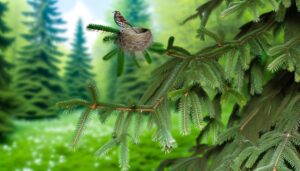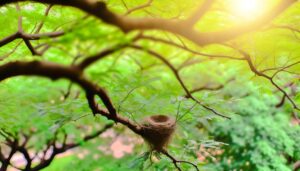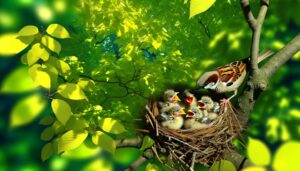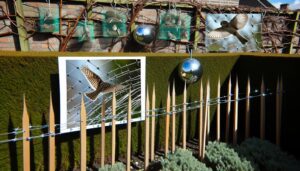7 Steps to Safely Remove a Sparrow Nest from Your Property
To remove a sparrow nest, first identify its location, such as eaves or vents, and observe if it's active. Check local regulations to guarantee compliance with wildlife laws.
Gather tools like a sturdy ladder, gloves, a flashlight, and a soft-bristled brush. Wear protective gear including gloves, safety goggles, and a dust mask.
Carefully dislodge the nest using a long-handled tool, applying gentle pressure without sudden movements. Be alert for any remaining birds or insects.
To effectively finish the process and address any future prevention measures, make sure your space stays secure from sparrows.

Key Takeaways
- Assess the nest's location and ensure no eggs or chicks are present before removal.
- Confirm local regulations and obtain necessary permissions for nest removal.
- Gather tools like a sturdy ladder, gloves, flashlight, and a soft-bristled brush.
- Wear protective gear, including gloves, safety goggles, and a dust mask.
- Carefully dislodge the nest using a long-handled tool, applying gentle pressure.
Assess the Situation
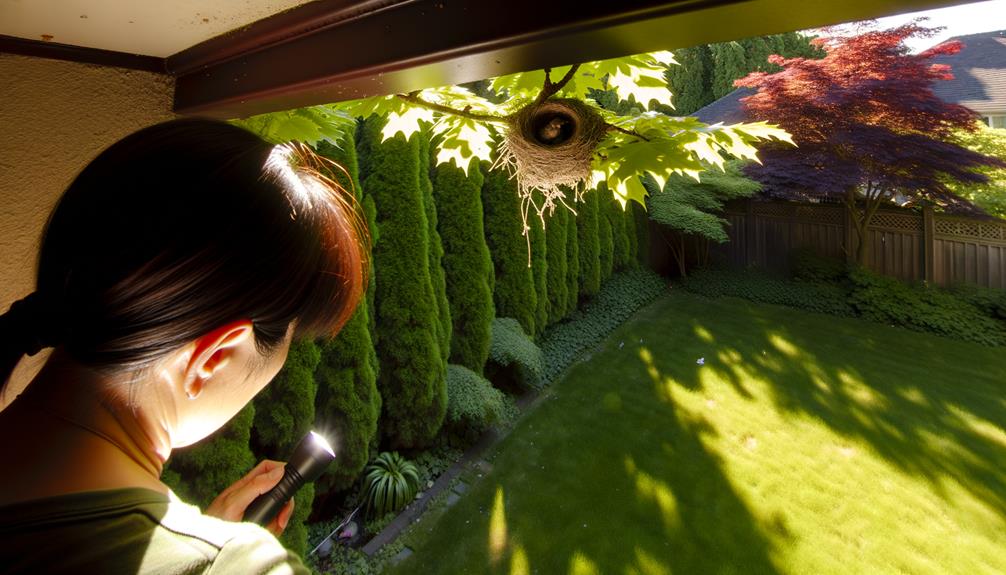
Before you proceed with removing a sparrow nest, carefully assess the situation to determine the nest's location, activity level, and potential legal restrictions.
Start by identifying the exact spot of the nest. Look for areas like eaves, gutters, or vents.
Observe the nest to gauge activity—note if sparrows are currently using it or if it's abandoned. Active nests may house eggs or chicks, requiring a more delicate approach.
Additionally, evaluate the nest's construction materials to understand potential hazards, such as mites or structural damage.
Check Local Regulations
Now that you've assessed the situation, you need to check local regulations to confirm that removing the sparrow nest complies with wildlife protection laws and guidelines. Begin by contacting your local wildlife agency or environmental department. These entities will provide you with specific laws regarding the removal of bird nests, as many species, including sparrows, are protected during certain times of the year, particularly breeding season.
Additionally, explore online resources or consult with a licensed wildlife rehabilitator for detailed information. Make sure you document any permissions or guidelines provided by authorities. Compliance with local regulations is essential to avoid legal repercussions and to guarantee humane treatment of the sparrows.
Always prioritize ethical considerations and community standards in your efforts.
Gather Necessary Tools
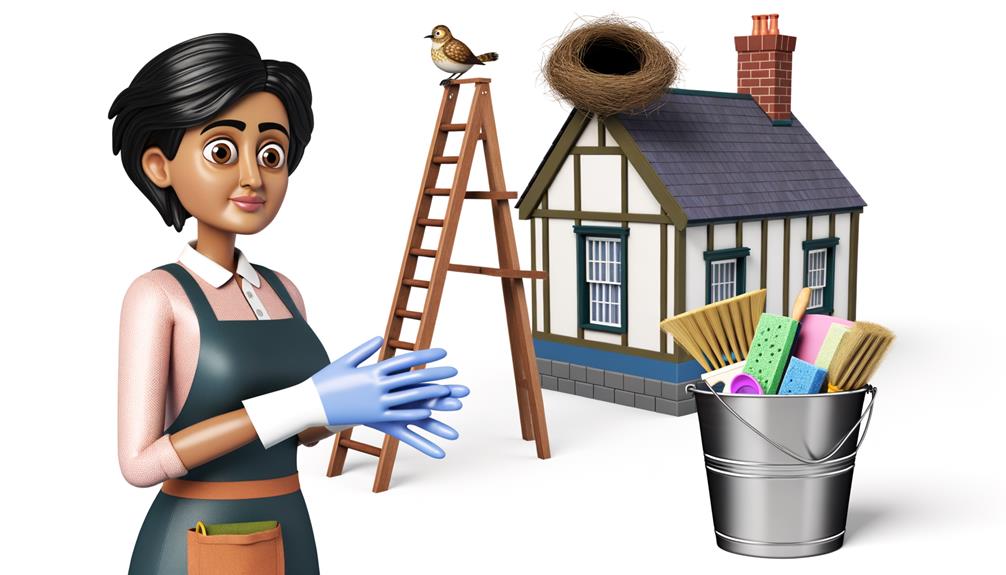
To effectively and safely remove a sparrow nest, you'll need to gather a specific set of tools designed for both your safety and the well-being of the birds.
Start with a sturdy ladder to reach high nests securely.
Use a pair of gloves to protect your hands from debris and potential bacteria.
A small flashlight will help you examine dark areas thoroughly.
Bring a soft-bristled brush to gently remove nest materials without damaging surrounding structures.
A sealable plastic bag is essential for containing and transporting the nest safely.
Finally, keep a disinfectant spray handy to clean the area afterward, preventing the spread of diseases.
Ensuring you have these tools will make the process efficient and humane.
Wear Protective Gear
Make certain you're wearing the appropriate protective gear, including gloves, safety goggles, and a dust mask to safeguard against debris, bacteria, and allergens during the nest removal process. This gear is crucial to protect your skin, eyes, and respiratory system. Gloves will prevent direct contact with potential contaminants, while safety goggles shield your eyes from particles. A dust mask is vital for filtering out harmful airborne substances.
Here's a quick reference table summarizing the protective gear and their purposes:
| Protective Gear | Purpose | Importance Level |
|---|---|---|
| Gloves | Prevents direct contact | High |
| Safety Goggles | Shields eyes from particles | High |
| Dust Mask | Filters airborne substances | High |
Always prioritize your safety to guarantee a smooth and hazard-free nest removal experience.
Remove the Nest

Carefully and methodically, use a long-handled tool to dislodge the sparrow nest from its location, ensuring you maintain a safe distance to avoid any sudden movements or debris. Position yourself securely and extend your arm to reach the nest. Apply gentle pressure to the base and edges of the nest to loosen it.
Be mindful of the following:
- Gentle Taps: Lightly tap around the nest's structure to break any adhesion.
- Controlled Movements: Avoid jerking motions that could cause the nest to fall unpredictably.
- Observation: Watch for any remaining birds or insects that might emerge.
Clean the Area
Once the nest is removed, thoroughly sanitize the area to prevent any potential health hazards or infestations.
Begin by donning gloves and a mask to protect yourself from allergens and pathogens. Use a mixture of water and a strong disinfectant to scrub the affected area, making sure you reach all nooks and crannies where debris might be trapped.
Pay special attention to any droppings, feathers, or nesting materials left behind, as these can harbor bacteria and parasites. After scrubbing, rinse the area with clean water and let it dry completely.
Prevent Future Nests

To prevent future nests, you should start by blocking potential entry points using materials like wire mesh or netting.
Next, implement deterrents such as reflective objects or noise devices to discourage sparrows from returning.
Consistently monitoring and maintaining these measures will guarantee long-term effectiveness.
Block Entry Points
Regularly inspect and seal any small gaps, cracks, or openings around your home to effectively block entry points and prevent sparrows from building future nests. Begin by thoroughly examining common entry points such as eaves, vents, and rooflines.
Use durable materials like metal mesh or caulking to guarantee a long-lasting seal. Pay close attention to areas where utilities enter your home.
Eaves and Rooflines:
Check for gaps or loose shingles that sparrows might exploit.
Vents and Chimneys:
Install vent covers or chimney caps to prevent access.
Utility Entry Points:
Seal around pipes, wires, and cables with caulk or expanding foam.
Use Deterrents
Implementing effective deterrents is essential in preventing sparrows from constructing nests around your home.
Start by installing bird spikes on ledges, eaves, and other flat surfaces where sparrows frequently perch. These spikes create an uncomfortable landing area, discouraging nesting.
Another option is reflective deterrents such as shiny tape or aluminum foil strips, which disorient sparrows and make the area less attractive.
Additionally, consider using sound deterrents that emit distress calls or predator noises to scare sparrows away.
For a more natural approach, place decoy predators like plastic owls or snakes near potential nesting sites. Regularly reposition these decoys to maintain their effectiveness.
Conclusion
You're almost there. You've assessed the situation, checked local regulations, gathered your tools, and donned protective gear. The nest removal went smoothly, and the area is now spotless.
But here's the essential part: preventing future nests. If you don't take action now, those sparrows will return, determined to reclaim their spot.
So, install deterrents and seal any entry points. Your dedication will pay off. Ready to outsmart those persistent little builders? Your effort will guarantee they won't nest again.

